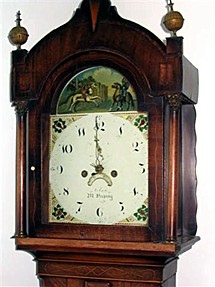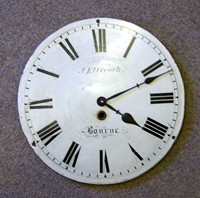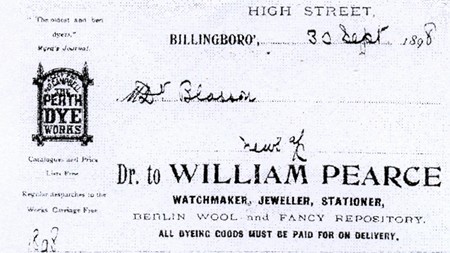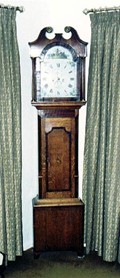|
Clock and watch making
The manufacture and sale of watches and clocks was a major occupation in past centuries and most towns and many villages had their own experts specialising in this field. In 1835, for instance, there were four in Bourne, Abraham Hopkin(s) and John Wilson in West Street, William Sharp in South Street and Thomas Wilson in North Street. By 1856, when the town’s population was less than 4,000, there was still sufficient business to support three watchmakers, William Cealey in South Street and John Stevens and Thomas Pearce in West Street. The most prominent of these was Thomas Pearce who came from a family of watch and clock makers at Stratford-on-Avon and moved to Bourne in 1842 at the age of twenty to start his own business after learning the trade with masters at Boston and Stamford. He spent a few years at premises in West Street before moving to larger accommodation at No 32 North Street where he established a business that was later taken over by his son Edward and lasted until the middle years of the 20th century. Numerous longcase clocks by Thomas Pearce have survived, often with the wooden cases made by John Wilcox of Dyke. No clocks bearing Edward's name are recorded perhaps because by 1890, longcase models were no longer in fashion, spring clocks, both English and imported being the main retail products together with the repair trade. Queen Victoria's diamond jubilee was marked in many towns and villages by the provision of a public clock, usually paid for by subscription. Edward Pearce was chosen to provide such a clock for the church tower at Swinstead, near Bourne, and a notice at the base of the tower records the contributors and that their payments totalling £65 15s. 0d. were "paid to Edward Pearce for making and fixing the clock" although it is doubtful if he actually made it himself and would have bought it from a specialist maker of turret clocks, although the mechanism does bear his name and the date 1897 engraved on the setting dial. The Swinstead timepiece is a flat bed clock typical of the period, the cast iron bed being three feet long, of eight day duration with a pin wheel escapement and the pallets fixed directly to the pendulum rod which beats 48 to the minute (11/4 seconds). Time is indicated on a single cast iron dial on the north face of the tower and the hours are struck on one of the existing peal of bells.
In 1899, Edward Pearce and Joseph Ellicock, who had a similar business in West Street, were given the job of building a new illuminated clock for the Town Hall in Bourne, the cost being met by donations and public subscriptions and it remained in use until badly damaged by fire in 1933. William Pearce, another son of Thomas Pearce who had trained in watch and clock making, also moved to Bourne and his name first appears in White's directory for 1872 as landlord of the Horse and Groom public house in West Street. He is still listed in West Street in 1882 but no longer working in the licensed trade and so was probably employed by his brother Edward but in 1885 he had moved to Billingborough and was in business as a stationer but by 1892 his activities had extended and he was listed as watchmaker, newsagent, printer, stationer, glass and china dealer. William died the following year at the early age of 43 but the business was carried on by his wife Emily Hall Pearce until her death in 1939 at the age of 93. Both William and Emily are buried in Billingborough churchyard.
A former Bourne resident, Mrs Heather Nash, has sent me a photograph of her own grandfather clock which keeps time at her house in Vancouver Island, British Columbia, Canada. It was originally owned by her grandfather, Bourne photographer William Redshaw (1856-1943), and came from their home at No 49 North Street, part of the North Street terrace. The clock bears the name Wilson of Market Deeping and is a fine example of a painted face from the 18th century when the style was popular. “It stood in our house for as long as I can remember”, said Heather, “and was left to me by my grandmother when she died. We had it shipped over to our previous home in Ottawa sometime in the 1960s and it still keeps excellent time after 200 years. Due to the extreme temperature variations between winter and summer in that part of the country, the casing suffered some warping. Recently, in line with the move to our new abode, we decided to have an antique restorer repair and refinish the woodwork and we are anxiously awaiting to see the results.” Wilson of Market Deeping may have been John Wilson who was working as a clock and watchmaker at Bourne during the late 18th century and specialised in painted dials. He was apprenticed to John Wood of Grantham before trading on his own account and by 1785 he had established a business in West Street, Bourne, and was advertising in the local newspaper for an apprentice. Between then and 1830, his business became known as John Wilson and Son with a branch in Narrow Bridge Street, Peterborough, and so it is quite possible that there was also a branch in Market Deeping. John Wilson died at Peterborough in 1827, aged 76, and John junior in 1842, aged 64.
Another example of the watchmaker’s craft comes from Alan Stennett of Woodhall Spa, near Lincoln, who has recently managed to track down a silver watch made by his great-grandfather, Edwin Goodacre, of Billingborough. The village was a famous centre for the manufacture of timepieces and the best known example locally is the village clock that can still be seen at Horbling on the side of a building that is now the Old Post Office and was also made by Goodacre. The original mechanism has been lost but an electrical movement was installed in 1991 when the parish council agreed to finance its upkeep with a regular supply of batteries to ensure that anyone who passes by will always know the correct time. Goodacre made the watch for his son-in-law Herbert Stennett (1881-1968), a local man who was one of the first Bourne volunteers to enlist with the 2nd Battalion, the Lincolnshire Regiment, for service in South Africa during the Boer War of 1899-1902. When the war ended, he joined the British South African Police Force for a spell and returned home in 1905 to take over the family farm. Alan actually bought it on eBay, the Internet auction site, a remarkable find that is now treasured as a family heirloom together with a silver tobacco box presented by the people of Bourne to Herbert and other Boer War volunteers when they returned home and an inscribed silver trophy for his loyal service during the conflict. A more famous name associated with clock making in Billingborough is that of Shaw, a family active in the village almost 300 years ago. The earliest mention on surviving timepieces is that of Joshua Shaw who was buried in the churchyard in the early 18th century. In March 1967, the Stamford Mercury investigated the provenance of a grandfather clock that had been in the ownership of a family from Armagh in Northern Ireland for more than three generations and bore the name of Abraham Shaw of Billingborough. The report concluded that there were many other clocks made by the family in homes around Britain and in the dominions and the colonies also bearing the name of Shaw but with different first names. It was therefore presumed that the business had been handed down from father to son over four generations. Following Joshua came Matthew who died in 1769, then Abraham who died in 1833 at the age of 72 and finally Samuel Barwis who died in 1876, aged 70. All are buried in the churchyard at Billingborough. The report added: "In addition to grandfather clocks, other timepieces were made for wall suspension brackets and mantle shelves. They were renowned as exceptionally good timekeepers, even after more than a century. The outstanding craftsmanship of their cabinets made them eagerly sought by collectors and dealers." The Bourne area therefore has a good record for the manufacture of clocks and watches in years gone by and no doubt other examples will surface in the future.
REVISED MARCH 2014 See also The Town Hall clock The church clock Thomas Pearce Herbert Stennett
Go to: Main Index Villages Index
|
||||||||||||||||



